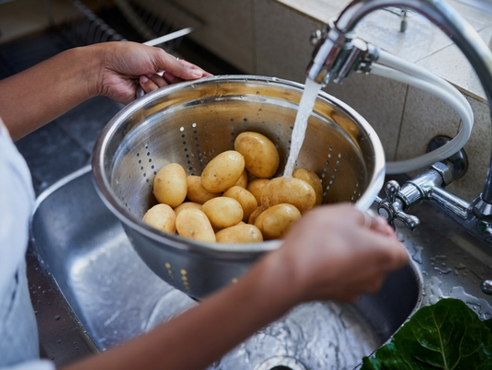HACCP: An essential alphabet for food safety in school kitchens

Did you know that children are considered a vulnerable population when it comes to food safety?
Schools participating in federal Child Nutrition Programs are required to have HACCP-based food safety plans. This will be verified by the Illinois State Board of Education when you have your administrative review. And although it may not be required by the county health department, they will ask to see temperature logs that happen to be a required part of the food safety plan.
So what does HACCP stand for?
HACCP stands for Hazard Analysis Critical Control Points. The concept has a focus on prevention instead of reaction. When we have the correct policies and procedures in place, (with all employees following them) we will be PREVENTING activity that can make our food unsafe. Best practices tell us to prevent illness instead of wait and then treat the illness. When using HACCP correctly, the foods being prepared in a commercial kitchen or school kitchen will have many check points to ensure they remain free of hazards including harmful bacteria. That being said, HACCP based plans do include reactions, or corrective actions, for when procedures aren’t followed the way they should be.
Let’s review the 7 steps of HACCP.
- Step 1: Conduct a Hazard Analysis
In this step, we identify all hazards through the entire flow of food – from off the delivery truck to the service line. Hazards include biological, chemical and physical.
- Step 2: Identify Critical Control Points
At what points in the flow of food could these contaminants be a problem? In school food service, common critical control points include receiving, storing, food preparation, holding and serving food, chilling leftovers, and reheating leftovers. However, there may be some differences by site. For example, a central kitchen might not be serving food or chilling and reheating leftovers. A satellite site might not have longer term storage for foods other than milk and some non-perishable items.
- Steps 3 and 4: Define Critical Limits and Monitor Critical Limits
Once we’ve identified food safety hazards and when/where they might occur, we can establish critical limits to control the hazards. In food service, this might be safe final cooking temperatures in meat or time used to hold foods. For example, the critical limit for cooking pork chops is 145F for 15 seconds. Or for example during receiving, dairy products should arrive at a temperature of 41 degrees or less. And when food is being held and served, hot foods should be at a minimum of 135 degrees. How do we know if critical limits are being met? For hot holding, we temp foods to make sure our critical limit is reached. During cooking, if we take the temperature of those pork chops and they’re 135F, we know the limit of 145F hasn’t been met yet. So we keep cooking. Another example is using test strips to test the sanitizer for washing dishes.
- Step 5: Establish Corrective Actions
Corrective actions create standard procedures for all staff to follow when critical limits aren’t being met. If hot food isn’t being held at the proper temperature, what would be your corrective action? For example, you could adjust the temperature setting on the warmer and verify that the food reaches 135F.
- Steps 6 and 7: Verify System and Keep Records
Finally, we verify that the system is being followed and we document. This may mean looking back at records to ensure logs are filled out, checking to make sure staff are wearing gloves and hairnets, and so on. Step 7 includes writing and updating the standard operating procedures which make up your HACCP plan. We’ll talk about standard operating procedures in our next post!
In the meantime, you can read more about HACCP at these links:
- Illinois State Board Education – Information on food handler training and inspection requirements for school food service, plus resources such as a downloadable handwashing poster from the Illinois Department of Public Health.
- Safe Food Alliance – An overview of HACCP with links to commonly asked questions, history of HACCP, and more. A free e-book, “The Beginner’s Guide to HACCP,” is also available for download.
- University of Florida – An overview of HACCP including the history of HACCP, plus how it relates to the Food Safety Modernization Act of 2011 and other food safety protocols (e.g., Good Manufacturing Practices).


